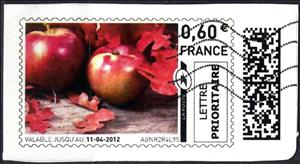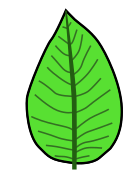Stamp: Autumn Leaves and Apples (France 2012)
Autumn Leaves and Apples (France 2012)
01 January (France ) within release MonTimbrEnLIgne. Food goes into circulation Stamp Autumn Leaves and Apples face value 0.60 Euro
| Stamp Autumn Leaves and Apples in catalogues | |
|---|---|
| Colnect codes: | Col: FR-TIM 2013-57/1 |
Stamp is square format.
Lettre PrioritaireAlso in the issue MonTimbrEnLIgne. Food:
- Stamp - Fruit face value 0.57;
- Stamp - Beaujolais Nouveau face value 0.56;
- Stamp - Coloured Truffles face value 0.60;
- Stamp - Chocolate Mmm face value 0.60;
- Stamp - Autumn Leaves and Apples face value 0.60;
- Stamp - Apple and Cinnamon face value 0.57;
|
Data entry completed
50%
|
|
|---|---|
| Stamp Autumn Leaves and Apples in digits | |
| Country: | France |
| Date: | 2012-01-01 |
| Emission: | Personalized - Official |
| Format: | Stamp |
| Face Value: | 0.60 Euro |
Stamp Autumn Leaves and Apples it reflects the thematic directions:
utumn, also known as fall in North American English,is one of the four temperate seasons on Earth. Outside the tropics, autumn marks the transition from summer to winter, in September (Northern Hemisphere) or March (Southern Hemisphere). Autumn is the season when the duration of daylight becomes noticeably shorter and the temperature cools considerably. Day length decreases and night length increases as the season progresses until the winter solstice in December (Northern Hemisphere) and June (Southern Hemisphere). One of its main features in temperate climates is the striking change in colour for the leaves of deciduous trees as they prepare to shed.
In botany, a berry is a fleshy fruit without a drupe (pit) produced from a single flower containing one ovary. Berries so defined include grapes, currants, and tomatoes, as well as cucumbers, eggplants (aubergines), persimmons and bananas, but exclude certain fruits that meet the culinary definition of berries, such as strawberries and raspberries. The berry is the most common type of fleshy fruit in which the entire outer layer of the ovary wall ripens into a potentially edible "pericarp". Berries may be formed from one or more carpels from the same flower (i.e. from a simple or a compound ovary).: 291 The seeds are usually embedded in the fleshy interior of the ovary, but there are some non-fleshy exceptions, such as Capsicum species, with air rather than pulp around their seeds.
A leaf (pl.: leaves) is a principal appendage of the stem of a vascular plant usually borne laterally aboveground and specialized for photosynthesis. Leaves are collectively called foliage, as in "autumn foliage", while the leaves, stem, flower, and fruit collectively form the shoot system. In most leaves, the primary photosynthetic tissue is the palisade mesophyll and is located on the upper side of the blade or lamina of the leaf but in some species, including the mature foliage of Eucalyptus,palisade mesophyll is present on both sides and the leaves are said to be isobilateral. Most leaves are flattened and have distinct upper (adaxial) and lower (abaxial) surfaces that differ in color, hairiness, the number of stomata (pores that intake and output gases), the amount and structure of epicuticular wax and other features. Leaves are mostly green in color due to the presence of a compound called chlorophyll which is essential for photosynthesis as it absorbs light energy from the sun. A leaf with lighter-colored or white patches or edges is called a variegated leaf.
Flora is the plant life occurring in a particular region or time, generally the naturally occurring or indigenous—native plant life. The corresponding term for animal life is fauna. Flora, fauna and other forms of life such as fungi are collectively referred to as biota. Sometimes bacteria and fungi are also referred to as flora, as in the terms gut flora or skin flora.




